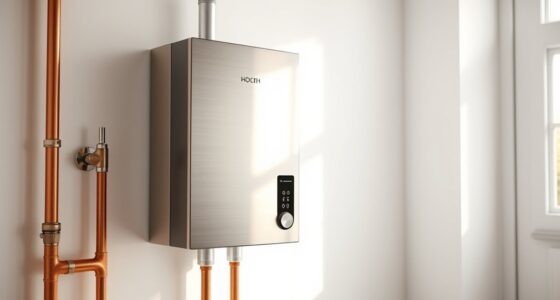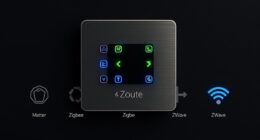In your smart home, voice data is often transmitted to cloud servers and stored based on company policies, so understanding how your data is used and protected is crucial. Make sure to use strong encryption, secure your Wi-Fi, and stay updated on device security. Review privacy policies carefully, disable voice recording when possible, and choose devices with robust security features. Continue exploring to learn simple steps that keep your home more private and secure.
Key Takeaways
- Understand which voice data is collected and how it’s transmitted to ensure transparency.
- Use strong encryption and secure networks to protect voice data during transmission and storage.
- Review and customize privacy policies, including data retention, sharing, and deletion options.
- Disable voice recognition features when not needed and keep device firmware updated for security.
- Implement best practices like two-factor authentication and network segmentation to minimize privacy risks.

As smart homes become more common, understanding data privacy is essential for protecting your personal information. When you integrate devices that use voice recognition, you’re giving these systems access to your spoken commands, preferences, and sometimes even private conversations. While voice recognition makes interacting with your smart home more seamless, it also raises concerns about how your voice data is stored and used. Many devices transmit your voice data to cloud servers for processing, which makes it vulnerable to interception if not properly secured. To safeguard your privacy, it’s crucial to ensure that these devices employ robust data encryption protocols. Data encryption transforms your voice data into a coded format, making it unreadable to anyone who intercepts it without the decryption key. This layer of security is vital because it prevents unauthorized access, especially during transmission over the internet. When choosing smart home devices, look for those that specify the use of end-to-end encryption, which guarantees that your data remains protected from the moment it leaves your device until it reaches the service provider’s servers. Additionally, regularly update your device firmware and software, because manufacturers often release security patches that address vulnerabilities in data encryption and other security features. You should also review the privacy policies of your smart home devices to understand how your voice data is stored, used, and shared. Some companies retain voice recordings to improve their services, while others limit data retention or offer options to delete your recordings. Understanding these policies helps you make informed decisions about what data you’re comfortable sharing. It’s also wise to disable voice recognition features when you’re not actively using them or to turn off voice recording history altogether if the device allows. This minimizes the amount of sensitive information stored by the system. Securing your Wi-Fi network with a strong password, enabling two-factor authentication, and segmenting your smart home devices on a separate network can further bolster your privacy defenses. These steps help contain any potential breaches and prevent hackers from accessing your entire network. Being proactive about security settings, encryption, and understanding how your voice data is managed ensures your smart home remains a convenient yet secure environment. Protecting your personal information isn’t just about technology; it’s about taking control of your digital footprint and making smart choices to keep your privacy intact. Implementing data privacy best practices is essential in maintaining your security in an increasingly connected world.
Frequently Asked Questions
Can I Completely Disable Data Collection in My Smart Home Devices?
You can disable some data collection features, but completely stopping it is tough because device privacy relies on manufacturer settings. Check your device’s privacy options and disable data sharing or collection features. Enable data encryption where possible to protect your info. Keep in mind, turning off certain features might limit device functionality. Regularly update your devices and review privacy settings to maintain better control over your smart home data.
How Are My Data Rights Protected Under Current Privacy Laws?
Your data rights are protected through laws that emphasize data ownership and consent management. You have control over your personal information, and companies must obtain your clear consent before collecting or sharing data. These laws ensure you can access, correct, or delete your data, giving you power over your privacy. Stay informed about your rights, and regularly review your device settings to maintain control over your data in your smart home.
What Are the Risks of Hacking Into Smart Home Systems?
You face cybersecurity threats that can lead hackers to access your smart home systems. Device vulnerabilities, like weak passwords or outdated firmware, make it easier for intruders to exploit these weaknesses. If hackers gain control, they could open doors, listen through microphones, or disable security features. To protect yourself, regularly update your devices, use strong passwords, and enable two-factor authentication. Staying vigilant reduces the risk of hacking and keeps your smart home secure.
Do Smart Home Devices Share Data With Third-Party Companies?
Yes, smart home devices often share data with third-party companies, but they use device encryption and data anonymization to safeguard your privacy. These security measures ensure that your personal information remains secure while enabling useful services. However, you should review device privacy policies regularly and adjust settings to limit data sharing, so you stay in control of your information and reduce potential privacy risks.
How Can I Identify and Prevent Privacy Breaches in My Smart Home?
You can identify and prevent privacy breaches by regularly reviewing your device settings for user consent options and enabling encryption techniques. Keep firmware updated, as updates often patch security vulnerabilities. Use strong, unique passwords and disable unnecessary features. Monitor your network activity for unusual behavior, and consider using a dedicated smart home network for added security. Staying vigilant helps protect your privacy and guarantees your smart home functions securely.
Conclusion
As you embrace smart home technology, remember that your privacy is the foundation of your comfort. Think of your data as a delicate garden—tend to it carefully, shielding it from prying eyes. Stay vigilant about your device settings and be cautious about what you share. Ultimately, safeguarding your information isn’t just about technology; it’s about preserving your freedom and peace of mind in a connected world. Protect your privacy, and your home remains truly yours.









